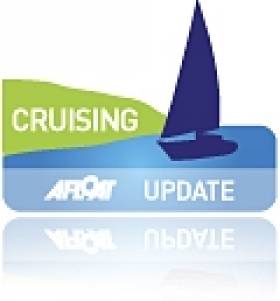Displaying items by tag: Kilronan
Aran Islands to Host WIORA 2023 at Kilronan
The 2023 West of Ireland Offshore Racing (WIORA) Championships will be sailed at Kilronan Harbour on Inismor, following a vote at the WIORA AGM last week.
Galway Bay Sailing Club with Cuman Seoltoireacht Kilronan as well as Foynes Yacht Club made bids to host the week and these were presented at the AGM.
Kilronan's successful bid has been hailed as a "significant benefit to sailing in the West of Ireland and the people of Aran".
In addition to promising another top-class sailing event in 2023, the regatta will be instrumental in supporting Kilronan in its bid to get permanent Pontoons in place, this process has already started, a GBSC spokeswoman told Afloat.
WIORA previously sailed on InisMor in 2017, as Afloat reported here.
Building on the experience of 2017 this will be a great social event. It will give a much-needed boost to a community hard hit by Covid, according to GBSC.
It's another feather in the cap for west coast sailing that also sees the Round Britain & Ireland Race Stopover arriving into Galway Port in 2022 as Afloat reported here.
Galway is deservedly renowned for its many summer festivals of arts, sport and culture, and in a week's time the sailing scene in Galway Bay becomes festive too, leaping to life with the annual Weekend Cruise (Friday July 17th to Sunday July 19th) for boats of all sorts from all around the great bay, with everyone heading out from their numerous home ports to assemble at Kilronan in the Aran Islands.
This unique annual event – organized by the indefatigable and always enthusiastic Pierce Purcell – will in turn usher in the WIORA (West of Ireland Offshore Racing Association) Annual Racing Festival, which will takes place under the Galway Bay Sailing Club burgee from Wednesday July 22nd to Saturday July 25th, but will be staged from the heart of the western capital at Galway Harbour rather than at GBSC's home anchorage across the bay at Rinville.
The Aran Islands weekend is of course strictly cruising, so the plan is to arrive in Kilronan in late afternoon on the Friday and meet up ashore, with other cruisers coming on Saturday. The WIORA sailors from Tralee, Foynes, Kilrush, Clifden and Westport are planning to arrive both days to meet up for a great WIORA & Galway Bay welcome in Kilronan.
The Aran Islands Hotel are putting on a buffet on the Saturday night at 8pm. A marquee is organised and a complimentary minibus is laid on back to the pier. Shower facilities have been arranged between 5 and 7pm to help provide a proper welcome for all participants by the Island and the hotel.
Although Sunday will see some of the fleet heading North in company, most will head to Galway Harbour, knocking on the sea-lock gate shortly after 1800hrs to be welcomed by Liam Burke, Rear Commodore Cruiser Racing GBSC, who is organising WIORA. It is hoped that many cruising boats will raft up in the docks during the racing event, but please give notice to Pierce in advance if you intend to do this.
Meanwhile, looking to next Friday and Saturday, on arrival in Kilronan, please regard the usual seamanlike proprieties by checking in with Harbour Master Patrick McDonagh. Two years ago in superb weather the Aran Islands Weekend Cruise had 50 boats in Kilronan, which was a record, but if summer returns again that number is very achievable, and a fleet of this size would require some berthing organisation
With nearly 300 boats now in the Galway Bay Cruising Group, Pierce can no longer phone everyone personally, so he asks that the word is passed on, and he'd appreciate knowing directly as soon as you can confirm you are joining the cruise.

Now comfortably sheltered within the breakwater, Kilronan retains its very special Galway islands character
As this event is officially under the aegis of the Cruising Association of Ireland (CAI), a number of East Coast members have been invited to join, and subject to numbers, arrangements are being made to charter a substantial cruising yacht which will be available at €120.00 per person - this will include a full day sail on the Saturday around the islands, with night on board and return to port on Sunday.
For the many cruising enthusiasts from other parts of Ireland who have often dreamed of sailing to the Aran Islands, this is a golden opportunity. And the Galway Bay Cruising Group isn't restricted to sailing cruisers– it also includes motor cruisers, sea anglers and suitably sized RIBs.
Pierce Purcell can be contacted at 087-279 3821, landline: 091-797927





























































